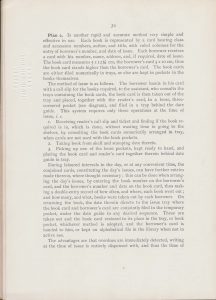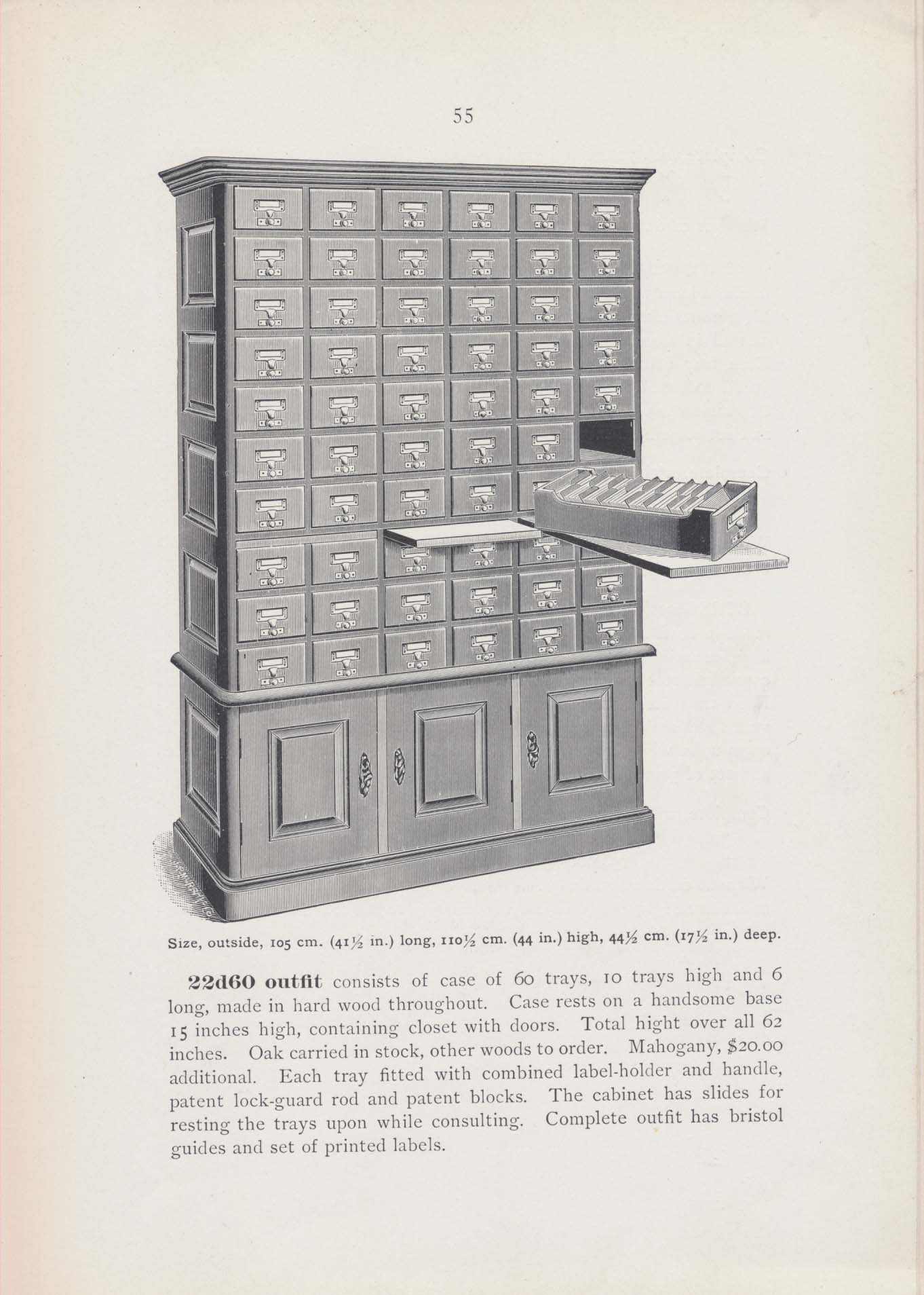What library equipment and supplies did our predecessors use? Some things have changed quite a lot while others remain somewhat similar. Let’s take a look at libraries from the past via this 1899 trade catalog.
The catalog is titled Classified Illustrated Catalog of the Library Department of Library Bureau (1899) by Library Bureau. Consisting of 171 pages, it includes everything from library furniture and shelving to card catalogs and charging systems for borrowing books.


An essential piece of equipment in any library is the book truck or book cart. In this 1899 catalog, it was described as “one of the most useful devices ever made for an active library.” Although many more useful devices have since been invented, book carts still remain an important part of the library. The book truck shown below is 40 inches long, 40 inches high, and 14 inches wide. It had the capacity to hold six book shelves. This book truck was made of oak with rubber wheels, and the sides of the cart were padded with rubber for extra protection. Just like today, book carts gave staff the opportunity to sit at their desks and work with several shelves of books at one time.

The Hammond Card Cataloger was a special typewriter for libraries, especially useful for typing catalog cards, shelf lists, reports, correspondence, etc. An attachment to hold catalog and index cards was especially handy. Interchangeable type wheels to accommodate most languages were also available. Most importantly for libraries, there was a type wheel with the cataloging characters from the “Library school card catalog rules.”

Another staple of the library in 1899 was probably the card catalog which staff used to search for and locate books or other library materials. Card catalogs were available in different sizes. Below is a 60 tray card catalog with a 15-inch high base. This particular one measured 5 feet 2 inches high. The base had built-in cabinets for storage. Convenient platforms slid in and out. Staff had the option of completely removing a tray to rest it on the platform while working, as shown below.

Smaller card catalogs, such as this 15-drawer one, could be placed on a table or base at a reasonable height. Therefore, staff were not forced to stoop over or stretch in awkward positions to reach the drawers. This particular base, or table, included a revolving top for added convenience.

This 1899 trade catalog also includes a few versions of charging, or circulation, systems. The systems included cards for both borrowers and books. In the system described below, each book had a book card noting its class, accession number, author, and title along with columns and space to write borrowers’ names and issue dates. It was kept either in a pocket in the book or numerically in a tray. Each borrower received a borrower’s card which noted their borrower number, name, address, and issue date. As shown below, the book card was slightly larger than the borrower’s card when placed in a loose pocket.


When borrowers wanted to check-out a book, they gave a call slip for the particular book to library staff who located its information in the card file and went to the shelf to pull the book. Once the book had been retrieved from the stacks, the date was stamped in the book. Both the book card and borrower’s card were placed in a loose pocket and filed behind the appropriate date guide in a tray at the circulation desk. Then, as time allowed, library staff had the option to go back to the day’s check-outs to enter the book number on the borrower’s card, and the borrower’s number and the date on the book card. This system assisted the library in tracking borrowing statistics and identifying overdues.
When the borrower returned the book, the date in the book directed staff to the appropriate location in the charging tray where the book card and borrower’s card had been filed together. Depending on the library’s procedures, the book card was either placed back inside the book pocket of the actual book or if book cards were not stored in the actual books, it was placed in a card file for future use. The borrower was given back their borrower’s card for their own safe keeping or it was kept in a file in the library for the next time they wanted to check-out a book. The book was then ready to re-shelve.
Another filing option was based on the borrower’s street address. This was useful for large cities especially in the case of an epidemic or outbreak of infectious disease. When the library was notified of an epidemic in a certain part of the city, library staff consulted the file system to determine which borrowers in that part of the city currently had books charged to them. Then the “local sanitary authorities” retrieved the books from those borrowers to disinfect the books before their return to the library.

Classified Illustrated Catalog of the Library Department of Library Bureau (1899) and other trade catalogs by Library Bureau are available in the Trade Literature Collection at the National Museum of American History Library. Interested in more library related trade catalogs? Take a look at posts about school libraries or bookcases, such as the “elastic bookcase,” adjustable book shelving, or revolving circular bookcase.


Be First to Comment